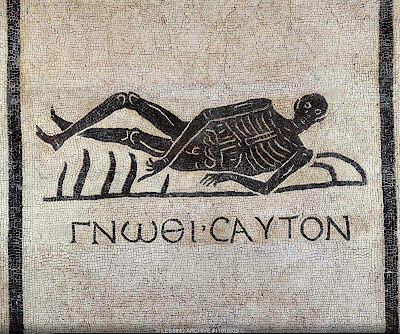 |
| skeleton with wine jugs, Naples Museum — a two-for-one carpe diem and memento mori. Love this guy. |
 |
| restored fragment of unswept floor from Aquileia. image: mosaico ravenna |
The previous post introduced the asaroton or unswept floor decoration that cropped up periodically in ancient Roman dining rooms. The debris-strewn look— trompe l'oeil mosaic food scraps, fish heads and the occasional animal gnawing on banquet remnants— remained a popular conceit for centuries. Explaining this motif as a sort of display of wealth (as it commonly seems to be in my cursory investigations) seems rather facile to me. If bourgeois ostentation is the goal why not simply create a mosaic larder heaped with edible riches that guests can trample on their way in to eating even more bounty?
A reader, Mosaicos La Pasera, commented:
I recall reading about the unswept floors in an article that explained the remnants of food on the floor represented and offering to the ancestors within the household.There may be the germ of something there. I read somewhere about the GREEKS who didnt sweep crumbs because they were "offerings" for the fallen (heroes/warriors). Also there was a type of Roman slave whose specific task was to sweep the food detritus on the floor, but I cant now find reference to it. Perhaps the asaroton was a way of venerating ancestors, fallen heroes and the like without, you know, making the place reek. Although I have yet to find a backstory that rings true on this, one thing is certain—the Ancients definitely had a way with wit and whimsy.
Memento mori: Another, mordant, take on Roman home decor: the memento mori. The term of course refers to that broad theme of art which crossed many genres, the purpose of which was to nag people "remember you will die." I associated the motif more with the self-denying, bummer obsession of medieval to early 19th century Christianity, but evidently it turns up rather jauntily in pagan times. These mosaics are thought to be the emblema or central panels from decorative flooring in Roman dining rooms.
The "Skull and Level" at top is absolutely riveting both in its look as well as complexity of symbolism. As described on the web site of the Institute and Museum of the History of Science in Florence:
....its naturalistic depiction of a skull and the tools of a mason, expresses allegorically the transience of life and the impending nature of death. It is the libella, the level, from which hangs the plumb-line—the instrument that serves to control the levelling of a construction- that symbolises all equality. From its ends hang in perfect equilibrium the symbols of power: the sceptre and royal purple on the left, and on the right, the sack and the stick, symbols of poverty...
Note that the skull sits atop a wheel (of Fortune!) and a butterfly, signifying the soul...
---> WOW. //
Also, take a look at an early post of mine on memento mori in fashion advertising.
---> WOW. //






3 comments:
Another great post that I will share with Mosaic Art NOW folks. Really appreciate your smarts, wit and research. Great fun to read.
Nancy! Thank you so much-- its so great to get feedback. As you might have seen mosaics are not my usual topic-- but I do get fixated on a subject and need to explore! So I'll explore Mosaic Art NOW.
Thanks again!
Speaking as a sign painter and sometimes tiler, leaving the black floor without ornament is just dead space. You would not do this with a rug either. Picture an oriental rug with a big splotch out of it. There would be furniture and rugs, etc. It is just a way of filling out the decoration/creating a balance.
=V.
Post a Comment